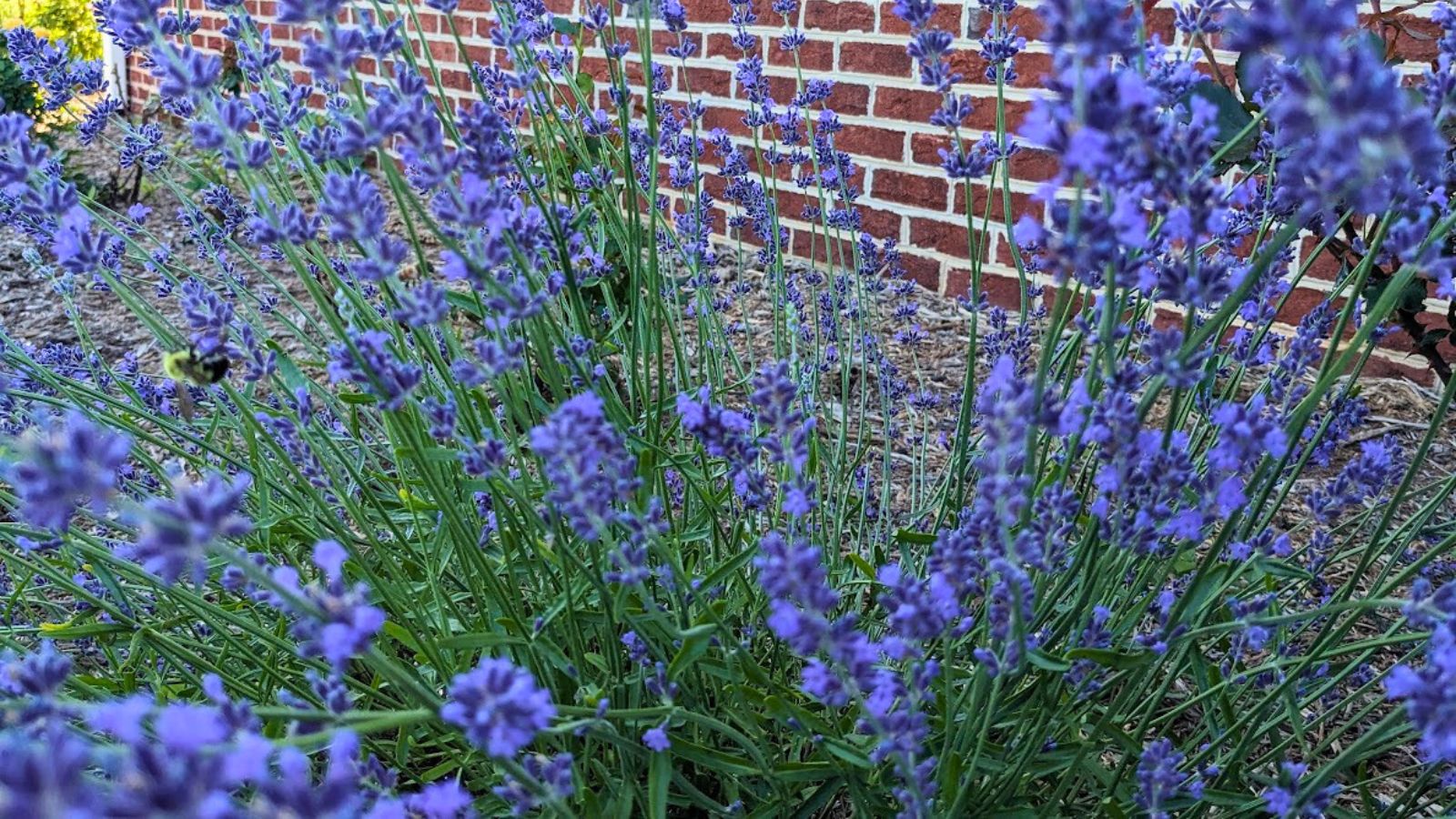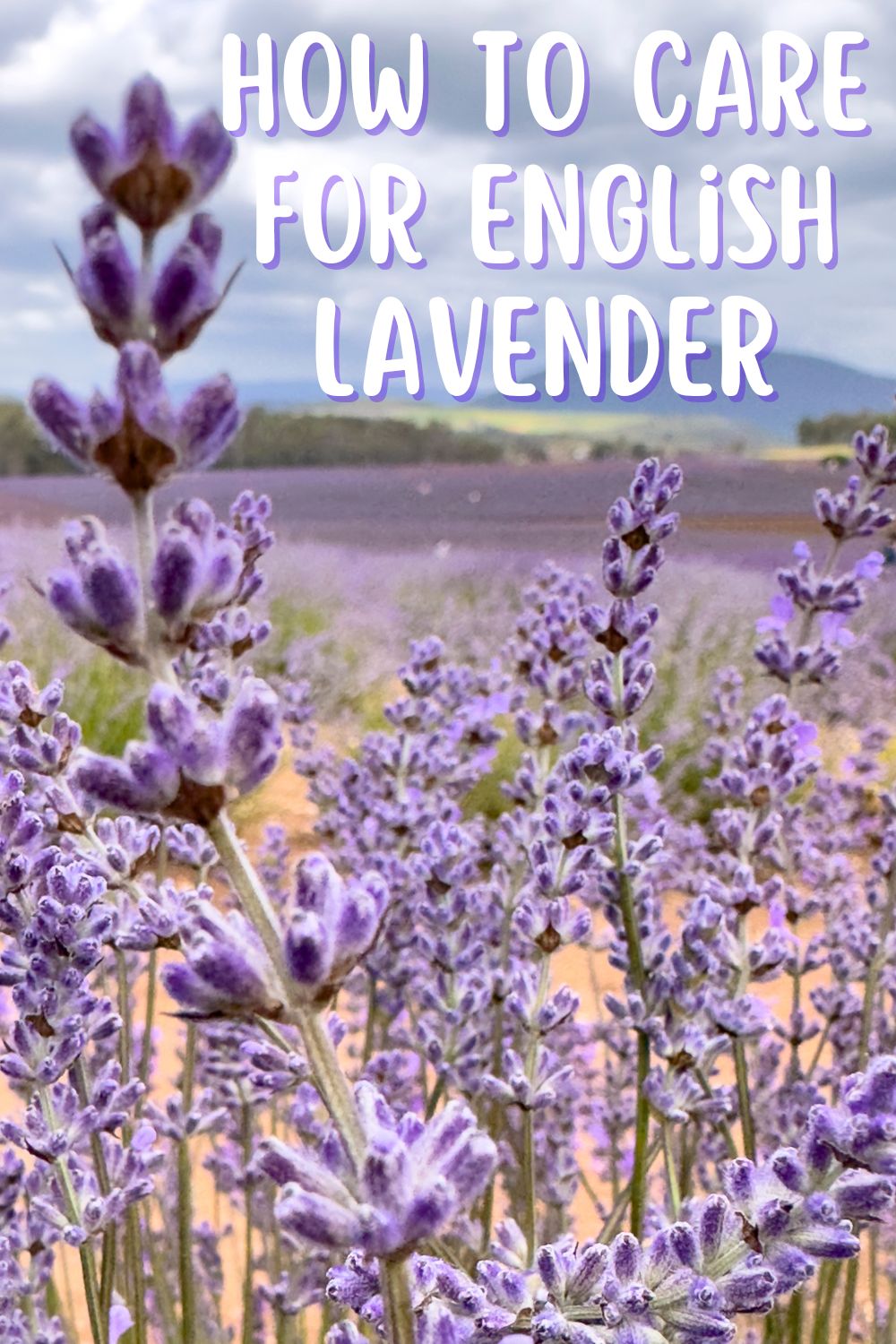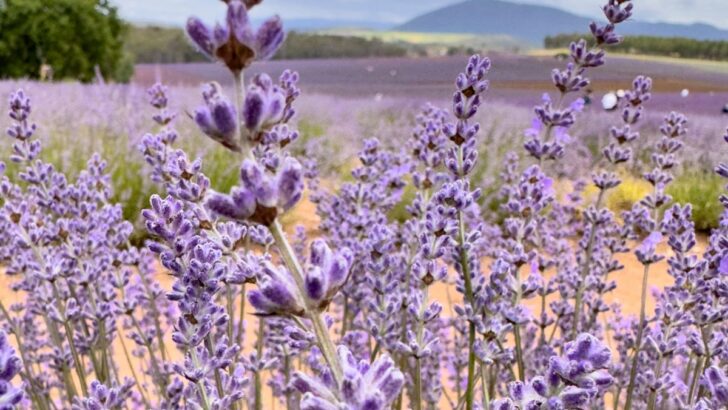English lavender (Lavandula angustifolia) is a deliciously fragrant purple perennial that needs to be in every garden. To make planting a few in your garden easy, here’s how to care for English lavender: it’s easier than you think.

This plant is a favorite of gardeners and flower lovers all over the world – and for good reason. English lavender is as useful as it is beautiful.
How to Care for English Lavender
What is English lavender?
Despite its name, English lavender is actually native to the mountainous regions north of the Mediterranean. This plant, often called true lavender or common lavender, is used for its flowers, which have a range of health benefits and practical uses.
English lavender is often harvested and dried to then be used to create essential oils. These oils are a common ingredient in skincare products and perfumes and have many medicinal benefits.
Lavender is also common in herbal teas, potpourri bowls, and even craft projects! English lavender has endless uses around the home, making it perfect for gardeners.
Planting English lavender
While this plant is known for being relatively hardy and not too fussy, it is still important to be careful where and how you plant it. If you don’t, it is unlikely that your English lavender plant will thrive.
Ideal location
English lavender thrives when given plenty of sunlight and space to breathe.
That means squeezing a lavender plant into a crowded part of your garden isn’t the best idea! You’ll want to plant your lavender to have ample room to grow – around 18 to 24 inches apart will do the trick.
Be sure that the location you choose to plant your lavender gets a decent amount of sunlight throughout the day. Otherwise, your plant will produce fewer flowers and may be more likely to contract diseases.
Soil preference
Lavender prefers well-drained, slightly alkaline soil, so try to use soil with a pH between 6.5 and 7.5. A gritty soil mix is generally the best choice for planting English lavender; anything sandy or gravelly will work well!
If you use dense soil that does not drain well, your English lavender will likely contract root rot from the soggy conditions. This disease will kill off your plant quickly, so selecting suitable soil is essential when planting your lavender.
Planting your lavender in a pot? Learn more about the best potting soil for lavender.
And here are 15 creative ways to use lavender in your landscape.
Watering needs
A fully grown lavender plant that has not bloomed will need around half a gallon of water every two weeks until the flower buds form. During its flowering period, lavender must be watered one to two times a week to keep it healthy and blooming.
Lavender is highly drought-resistant, so you can decrease watering again after the blooming season.
It is easy to tell if you are over-watering or under-watering your lavender. If the plant is overwatered, you will notice yellowing on the leaves, sodden soil, and an odor of rot. If the lavender is underwatered, the soil will be noticeably dry, and the stems will droop considerably!
Feeding and fertilization
Lavender doesn’t need to be fertilized often; just once or twice a year will generally do the trick!
In the springtime, add around one inch of your compost directly into the plant soil right at the start of the growing season.
Ensure you don’t over-fertilize your lavender, as this can cause the plant to produce far fewer flowers than it usually would.
But if your plants are struggling, try a slow-acting organic fertilizer (best lavender fertilizer). Conventional flower fertilizers are generally unsuitable for lavender due to their high nitrogen and acid content. You’ll be much better off feeding your English lavender with a simple organic compost.
Pruning and maintenance
The best time to prune lavender is right after it has finished flowering. With a pair of pruning shears, cut back around ⅓ of the plant, starting with the dead stems and flower heads and gradually forming the plant into a mound shape.
Pruning your lavender plants is extremely important. It will make it more visually appealing, prevent the lavender from going woody, and promote new flower growth.
Regularly trimming dead stems and flower heads will also encourage new growth—just be sure you don’t chop too much off!
Pest and disease management
When planted in the right conditions, lavender plants have few pests and diseases.
The most common pests targeting this plant are aphids, whiteflies, and spider mites. These pests tend to target lavender plants that grow in nitrogen fertilizer, so if you’re fertilizing the plant correctly (remember – organic compost is best!), you shouldn’t have too many issues.
Blasting the bugs off with water and wiping down the leaves with a neem oil solution typically does the trick.
As for potential diseases, watch for root rot and lavender Shab disease.
- Root rot is generally caused by a damp environment and occurs often during rainy seasons. You can prevent this by ensuring your lavender is planted in soil that is not too moist and has good drainage, which can be achieved by adding sand and gravel.
- Lavender Shab disease, however, doesn’t have a quick fix. This is why prevention is key! Buying only certified disease-free lavender plants and not taking any cuttings from infected lavender is your best bet for Shab. If you have any Shab-infested plants in your garden, dig them up and burn them, as this disease is windborne and can spread quickly.
Learn about the most common lavender problems.
English lavender winter care
English lavender is a notoriously hardy plant in zones 5 through 9 and should generally survive the winter months with no issues. However, there are some measures that you can take to ensure that your plant thrives in more extreme winter climates.
If you’re in a colder climate, covering your plant base with a layer of mulch and covering the outside of the plant itself with a thin, breathable fabric will help protect your lavender from harsh winds and freezing temperatures. Just be sure that if you decide to use mulch, it is a type that drains well, as anything else poses the risk of root rot.
Harvesting and usage
What time of year you harvest lavender depends entirely on what you plan to use the plant for!
- If you want to stock your home with dried lavender bundles for cooking or crafts, harvest them early in the season when the blossoms first open.
- If you’re harvesting to make essential oil, gather a bit later in the season instead (once most of the blossoms have opened).
The best way to dry lavender is by hanging bundles upside-down in a dark, warm, dry room. You’ll want to keep the air circulating, so having a fan in this room will help immensely!
Lavender can take around six weeks to dry completely; you’ll know it has properly dried if the stems snap when bent. Once dried, the best storage option is an airtight container, kept well away from light and heat.
Most Popular English Lavender Varieties
Several English lavender varieties are popular among gardeners for their unique characteristics, fragrance, and adaptability. Some of the most well-known English lavender varieties include:
Munstead (Lavandula angustifolia ‘Munstead’): Compact and early blooming, Munstead is a favorite for its dense spikes of deep purple flowers and aromatic foliage.
Hidcote (Lavandula angustifolia ‘Hidcote’): Known for its deep purple flowers and silvery-gray foliage, Hidcote is a classic English lavender with a strong fragrance.
Ellagance Series (Lavandula angustifolia ‘Ellagance’): This series includes various cultivars, such as Ellagance Purple and Ellagance Ice, known for their compact growth, long bloom period, and vibrant colors.
Royal Velvet (Lavandula angustifolia ‘Royal Velvet’): With dark purple flowers and a strong lavender scent, Royal Velvet adds a touch of luxury to gardens.
Twice-Flowered Series (Lavandula angustifolia ‘Twice-Flowered’): Varieties like ‘Blue Spear’ and ‘Lusi Purple’ in this series produce two sets of flowers per season, extending the blooming period.
Hidcote Pink (Lavandula angustifolia ‘Hidcote Pink’): A softer alternative to traditional purple varieties, Hidcote Pink offers delicate pinkish-purple blooms.
Folgate (Lavandula angustifolia ‘Folgate’): This variety is valued for its silvery foliage and long stems of lavender-blue flowers.
English lavender varieties include Jean Davis, Sarah, Vera, Lady, Provence, Grosso, and Dutch Mill.
Learn About Growing Other Lavender Varieties
- 5 lavender types and their uses
- how to care for a lavender tree
- how to care for Spanish lavender
- culinary lavender varieties
- how to care for French lavender
English lavender is a very hardy plant that is not particularly difficult to care for. Keeping an eye on potential pests, watering it correctly, and pruning the plant yearly will generally be enough to keep your lavender healthy and blooming. By drying your lavender and packaging it up in airtight jars or bags, you’ll have a key ingredient that you can use for countless purposes. Whether it’s skincare, essential oils, or cooking, your lavender is bound to come in handy. With the correct soil, an ideal planting location, and proper upkeep and maintenance, you’ll have stunning flowers to harvest next blooming season!




![Greenwood Nursery/Live Perennial Plants - Hidcote Blue Lavender + Lavandula Angustifolia - [Qty: 2X Pint Pots] - (Click for More Options/Quantities) Greenwood Nursery/Live Perennial Plants - Hidcote Blue Lavender + Lavandula Angustifolia - [Qty: 2X Pint Pots] - (Click for More Options/Quantities)](https://m.media-amazon.com/images/I/71HGM-0m74L._SL500_.jpg)

![Greenwood Nursery/Live Perennial Plants - Royal Velvet Lavender + Lavandula Angustifolia - [Qty: 5X Pint Pots] - (Click for More Options/Quantities) Greenwood Nursery/Live Perennial Plants - Royal Velvet Lavender + Lavandula Angustifolia - [Qty: 5X Pint Pots] - (Click for More Options/Quantities)](https://m.media-amazon.com/images/I/61+-4EVk1wL._SL500_.jpg)
